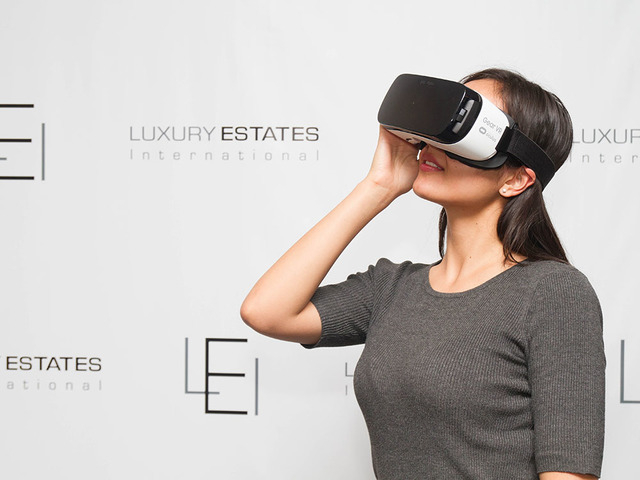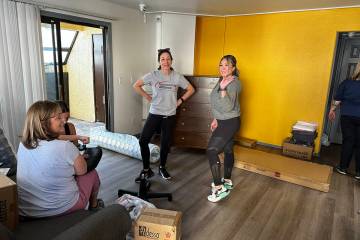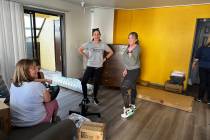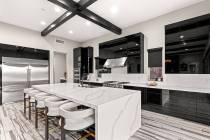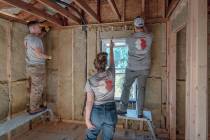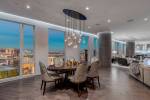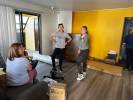Virtual reality presentation can transport visitors into a Veer unit
Kamran Zand, real estate broker and founder of Luxury Estates International, has teamed with Fraser Almeida, creative director of Luxury Homes Photography, to video record one the first virtual reality presentations of a high-rise condominium atop the Veer Towers at City Center on the Las Vegas Strip.
Zand and Almeida have been applying virtual reality technologies to show potential buyers an immersive viewing experience of condominium unit No. 3502 on the 35th floor of the Veer Towers at 3722 Las Vegas Blvd. South.
The Veer Towers are a mind-bending visual experience unto themselves. Architect Helmut Jahn designed each of the two towers to defy gravity by tipping away from each other at an angle of five degrees inclination, even steeper than the Leaning Tower of Pisa in Italy. The resulting benefit is that every window on the tipped side of a tower has a view that faces outward and straight down to the ground, unobstructed by lower floors.
To get in Zand’s virtual tour, a potential homebuyer dons a Samsung VR Gear head-mounted display, or HMD, and sits in a comfortable armchair that can swivel 360 degrees within the office lobby. Once the lenses of the HMD are adjusted for focal depth, the video experience begins when the viewer gazes at a blue line that acts like a mouse cursor. Turn the head to point the tip of the blue line at a triangular “play” button on the view screen, then tap an outer switch on the right side of the HMD to start the video.
Photorealistic images of the condominium’s luxury amenities appear and begin to swim around the HMD lenses, over and under the viewer’s eyes, responding in real time to the movement of the person’s head.
To comprehend what it feels like to experience an immersive 3-D point of view, imagine you are seated on a barstool in the living room of Veer Towers unit No. 3502. The barstool can swivel 360 degrees.
Then imagine the legs supporting the barstool have disappeared, so you only see the tiled floor 5 feet below, while you hover in the center of the room. A feeling of vertigo starts to intrude, until you look upward. The image projected in front of your eyes gradually changes, panning up in synchronization with your head movement, from the floor to the inside front door to the bubble-globe chandelier overhead.
Push off with your foot on the real floor below you, so that your seat swivels around 180 degrees. You are now looking behind you at the rest of the main room, which just happens to be populated with two women in black dresses seated on a living room couch, who smile back at you while two men play pool on a billiards table to the side of the lounge area. All four interact in front of large panoramic windows that showcase a stunning view of the Strip and the valley beyond. The sun gradually has been setting as twilight nears and the party begins.
Continue rotating your swivel chair to take in all the expanse of the main room, including the open kitchen, dining room, rugs, art and ceiling fixtures.
Look again toward the front door of the room that is opening inward as your host and chaperone, Kamran Zand, enters the main room. He introduces himself and welcomes you to browse the luxury home as you listen through the speakers inside the head-mounted display.
Priced at $3.5 million, the high-rise condominium includes 3,419 square feet with two bedrooms and 2½ baths. Black-and-white-swirled marble covers the kitchen countertops and island gathering space. Cooking appliances are from Bosch.
Zand walks away toward the master bedroom.
As he disappears into the room, your field of view changes and you are teleported into the center of the bedroom as Zand enters. He is once again walking toward you, as if you just moved to the next level of a video game. There is another man and woman in the room who add depth perspective to the king-sized bed, couch, armchair and adjoining window view of the Strip.
The couple stand up from the couch near the window and walk past you, smiling at eye level, as if you were standing next to them. The presence of people in the room allows you to gauge the spatial relationships between the walls, ceiling, floor and furniture. But as you look down, you have no feet, your vision floats 5 five feet above a pristine white shag rug.
Zand again walks ahead of you, disappearing into the closet of the master bedroom. Instantly you are teleported inside the center of the spacious closet as your host walks through the entrance now in front of you. He walks past and starts to change his jacket in front of a mirror, in order to present a relative perspective that shows the closet size and dimensions. You slowly rotate 360 degrees to take in all the different clothes drawers and staging areas within the room, while gazing above and below at the surrounding wooden cabinetry and storage spaces.
After changing his jacket, Zand walks outside the closet. You are again teleported to the center of the main room, facing the inner front door. As his guests walk by you to go outside, Zand emerges from the bedroom hallway and turns off the lights to the main room, except for a small lamp by the front door. He follows his guests into the outside hall.
When you swivel your armchair to look behind you, night has descended and the glittering lights of the Strip illuminate the panoramic windows as motorized shades start to descend for privacy.
The term “virtual reality” originally was popularized by Jaron Lanier of VPL Research, a video game creator who had worked with researchers from Atari at their Advanced Sunnyvale Research Laboratory in Silicon Valley during the 1980s. The Atari research labs, led by video pioneer Alan Kay, explored human-machine interface technologies for video games and digital graphics, attempting to create “virtual” environments where players felt as if they were inside the game and surrounded by it.
Today, 30 years after the first wave of integrated virtual reality technologies were coupled with 3D stereographic images and expensive supercomputers, a renaissance of sensors, LCD displays, and smartphone technologies have driven costs down. A new virtual reality industry is ready for a growth spurt at local retail stores.
Google has created Cardboard, an inexpensive 3D viewing platform consisting of two lenses inside a cardboard box that allow a mobile phone to be mounted sideways and held in front of the head with a rubber band to create a cheap, but engaging, head-mounted display.
Android smartphones now can download free apps from the Google Play Store that morph a mobile phone display into a split-screen stereoscopic viewer. Apple has similar apps available from its App Store for its iOS-based mobile phones.
Samsung VR Gear and Mattel ViewMaster are more consumer-friendly, plastic versions of the Google Cardboard mobile phone holder that are now available at local retail stores from $40 to $100.
Almeida has employed the Samsung VR Gear head-mounted display, a Samsung Galaxy mobile phone and a swiveling white armchair as his virtual reality media platform.
He captured the 3D images from inside Veer Towers unit 3502 by using a special photography rig that included six GoPro HERO cameras mounted onto a hollow cube. The photocube captures 4K Ultra-High-Definition video images that are streamed from each of its six cameras at the same time.
The entire video camera array is tipped onto one corner of the cube that mounts on a single-pole tripod in the center of a room. Streaming videos of the ceiling, floor and all four walls are recorded in parallel on each camera. Real people roam through the space at choreographed intervals to give spatial and depth references to the furniture, appliances, art and amenities shown by all six cameras from six different perspectives.
GoPro recently purchased the company Kolor, whose software engineers have refined the art of “stitching” together all six video camera sequences, so that they appear meshed together as one continuous image inside a panoramic, 360-degree sphere of reference.
Once the stitched, moving images have been processed into a combined video format, the files can be imported into a video editor like Adobe Premiere Pro CC. Music, text, graphics and narration tracks can be edited and synchronized with the video presentation. The finished production is then uploaded to a YouTube channel or to the GoProVR website for mass distribution.
Any potential homebuyer who owns a Samsung VR Gear headset can download the YouTube video to their mobile phone and virtually teleport themselves inside the 35th floor of the Veer Towers at MGM City Center above the Las Vegas Strip.
“Soon everyone will have access to these tools,” Almeida said, “but a videographer’s creative talent to capture and edit these images will still be necessary, to produce an immersive experience that is engaging and compelling.”
The 3D immersive experience allows the viewer to have more freedom to explore spatial relationships within a potential home and study every feature in more detail.
While an edited 2D video presentation assumes the viewer is a passive observer from the outside of the image, who must be guided sequentially through each room by a director, a 3D immersive video has very little external direction. Start the viewer in the center of each scene and chaperone the eyes between room scenes when self-guided exploration is completed, much like a video game experience.
The immersive experience produces a more luxurious feeling of “being there” inside the photorealistic depiction of the condominium living space.
Higher-end virtual reality and augmented reality experiences on advanced computer gaming platforms are just starting to be offered by industry leaders like Oculus, HTC, Valve, Sony, Samsung, Apple and Microsoft who have been demonstrating glimpses of the exciting technologies to come.
Imagine being able to not only swivel on your armchair in horizontal 3D space, but also stand and walk around a room to examine the furniture, kitchen appliances, and spectacular window view of the Strip from all angles and even up close.
Control a dimmer switch on a virtual wall to adjust the room lighting, test the touchscreen panel system to adjust the music volume and balance, try the kitchen appliance controls and even flush the toilet.
Virtual reality technologies can depict more clearly how a custom home might look and feel, before it is built. Real-time immersive editing might soon allow a custom homebuyer to walk around inside a 3D graphic rendering of their future floor plan, in order to move the walls around, place windows and skylights, and arrange furniture so that the homebuilder and homebuyer can view how each change affects the living space.
Video and graphic artists are excited about the new tools that are emerging that can help them create unique and fulfilling virtual worlds.
During the recent NAB 2016 Expo in April, the National Association of Broadcasters hosted a Virtual Reality and Augmented Reality Pavilion in the North Hall of the Las Vegas Convention Center.
“In order for the process of creative discovery to begin, the technical details need to be figured out and become transparent,” Halsey Minor said during a presentation at the Iron Yard in downtown Las Vegas during the expo2016. Minor is an entrepreneur, who was a founder of CNET, one of the first digital news publication channels on the Internet. He is now promoting the Quantum Leap professional 3D video camera, along with the software editing and distribution tools necessary to build an “end-to-end” platform for VR content creators.
Starbucks and other coffee houses may soon be providing VR viewing stations as part of an Internet cafe experience for mobile phone users. Pop your mobile phone inside an HMD, sit down in a swivel armchair, and travel to a far-off corner of the world or into a fantasy realm.
Just be careful not to spill your coffee as you spin.





